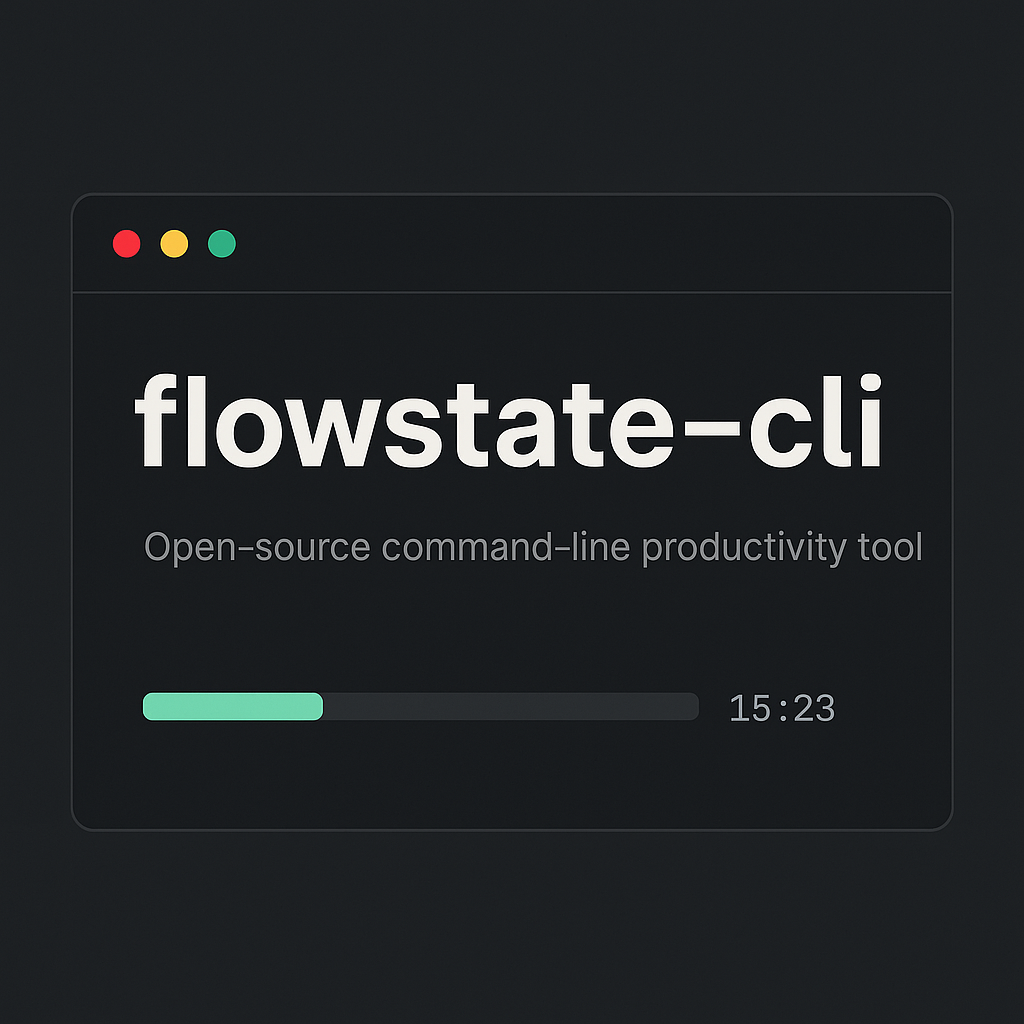Overview
FlowState-CLI started as a personal itch I needed to scratch. As someone who lives in the terminal, I was tired of switching to web apps or GUI tools just to track tasks or start a Pomodoro timer. I wanted something lightweight, fast, and that worked the way I work - entirely from the command line.
What started as a simple script grew into a full productivity tool that I now use internally for all my task management and focus sessions.
The Problem I Was Solving
Existing productivity tools had several issues for my workflow:
- Context switching: Having to leave the terminal broke my flow
- Heavyweight solutions: Most tools were overkill for simple task tracking
- Cloud dependency: I wanted something that worked offline but could sync when needed
- Poor CLI experience: Web-first tools with afterthought terminal interfaces
I needed something that felt native to the terminal while being powerful enough for real productivity work.
How I Built It
Core Architecture
- Language: Python with Typer for the CLI interface and Rich for beautiful terminal output
- Local Storage: SQLite for offline-first task management
- Backend Services: FastAPI + PostgreSQL for optional cloud sync
- Authentication: JWT-based auth for sync features
- Deployment: Packaged and published to PyPI for easy installation
Key Features I Implemented
Task Management
# Quick task creation and management
flow task add "Implement user authentication"
flow task list --status active
flow task complete 123
Pomodoro Timers
# Start focused work sessions
flow pomodoro start --task 123 --duration 25
flow break start --duration 5
Technical Deep Dive
The beauty of FlowState-CLI is in its simplicity. Here’s how the key components work:
Local-First Architecture
# SQLite for offline functionality
class TaskManager:
def __init__(self, db_path="~/.flowstate/tasks.db"):
self.db = sqlite3.connect(db_path)
self.setup_tables()
def add_task(self, description, project=None):
# Store locally first, sync later
task_id = self.db.execute(
"INSERT INTO tasks (description, project, created_at) VALUES (?, ?, ?)",
(description, project, datetime.now())
).lastrowid
# Queue for sync if online
if self.sync_enabled:
self.queue_for_sync(task_id)
return task_id
Clean CLI Interface Using Typer and Rich, the CLI feels responsive and looks great:
@app.command()
def add(description: str, project: Optional[str] = None):
"""Add a new task"""
task_id = task_manager.add_task(description, project)
console.print(f"✅ Added task {task_id}: {description}", style="green")
@app.command()
def pomodoro(duration: int = 25):
"""Start a Pomodoro session"""
with Progress() as progress:
timer_task = progress.add_task(f"Focus time: {duration}m", total=duration*60)
# Timer logic with live updates
Optional Cloud Sync The sync functionality is built as an optional layer:
class SyncManager:
def __init__(self, api_base_url, jwt_token):
self.api_client = httpx.AsyncClient()
self.token = jwt_token
async def sync_tasks(self):
# Push local changes to server
local_changes = self.get_local_changes()
await self.api_client.post("/sync", json=local_changes)
# Pull remote changes
remote_changes = await self.api_client.get("/sync/latest")
self.apply_remote_changes(remote_changes)
Real-World Usage
I’ve been using FlowState-CLI daily for my own work, and it’s become an essential part of my development workflow:
- Task Management: Quick capture of ideas without leaving the terminal
- Focus Sessions: 25-minute Pomodoros while coding or studying
- Project Tracking: Organizing work across different repos and clients
- Time Awareness: Understanding where my productive hours actually go
Example Workflow
# Start the day by reviewing tasks
$ flow task list
# Add a new feature to work on
$ flow task add "Implement user authentication" --project web-app
# Start a focused work session
$ flow pomodoro start --task 123 --duration 25
# Take a break when the timer ends
$ flow break start --duration 5
# Mark task as complete
$ flow task complete 123
What I Learned
Building FlowState-CLI taught me a lot about:
- CLI UX Design: Making terminal interfaces that feel intuitive and responsive
- Local-First Software: Designing apps that work offline but sync when possible
- Python Packaging: Getting a CLI tool properly packaged and distributed to PyPI
- Background Processes: Handling timers and notifications without blocking the terminal
Future Plans
The tool is stable and functional for daily use, but I have some ideas for enhancements:
- Better Analytics: More detailed insights into productivity patterns
- Plugin System: Allow custom commands and integrations
- Team Features: Shared projects and team productivity tracking
- Integration APIs: Connect with other tools like Git, Slack, etc.
Try It Yourself
FlowState-CLI is available on PyPI and ready to use:
pip install flowstate-cli
flow --help
The tool is designed to be immediately useful without configuration, but flexible enough to adapt to different workflows. Give it a try if you’re looking for a terminal-native productivity solution that respects your privacy and keeps you in your flow state.
Want to contribute or have ideas for features? The project is open to collaboration - reach out and let’s build better productivity tools together.
Example Usage
Task Management
flowstate add "Write project documentation"
flowstate list
flowstate start 1
flowstate done 1
flowstate rm 1
Pomodoro & Focus Timer
flowstate pom start
flowstate pom break short
flowstate pom stop
flowstate pom status
Distraction Blocking (Flow State Mode)
flowstate mode on # Block distracting sites
flowstate mode off # Unblock
Productivity Stats
flowstate stats
Configuration
flowstate config show
flowstate config set pomo_duration 30
flowstate config set notifications true
Project Setup
Dependencies
pip install flowstate-cli
Configuration
- All settings are managed via a simple config file or CLI flags.
- Session logs and task data are stored locally for privacy and review.
Impact
flowstate-cli is helping developers and creators:
- Reduce distractions and context switching
- Build sustainable deep work habits
- Track and reflect on their productivity
- Automate and script their focus routines
Conclusion
flowstate-cli is more than just a timer, it’s a complete productivity platform for the terminal. By combining simplicity, privacy, and extensibility, it empowers anyone to reclaim their most valuable resource: attention.
For more projects, check out my portfolio!



